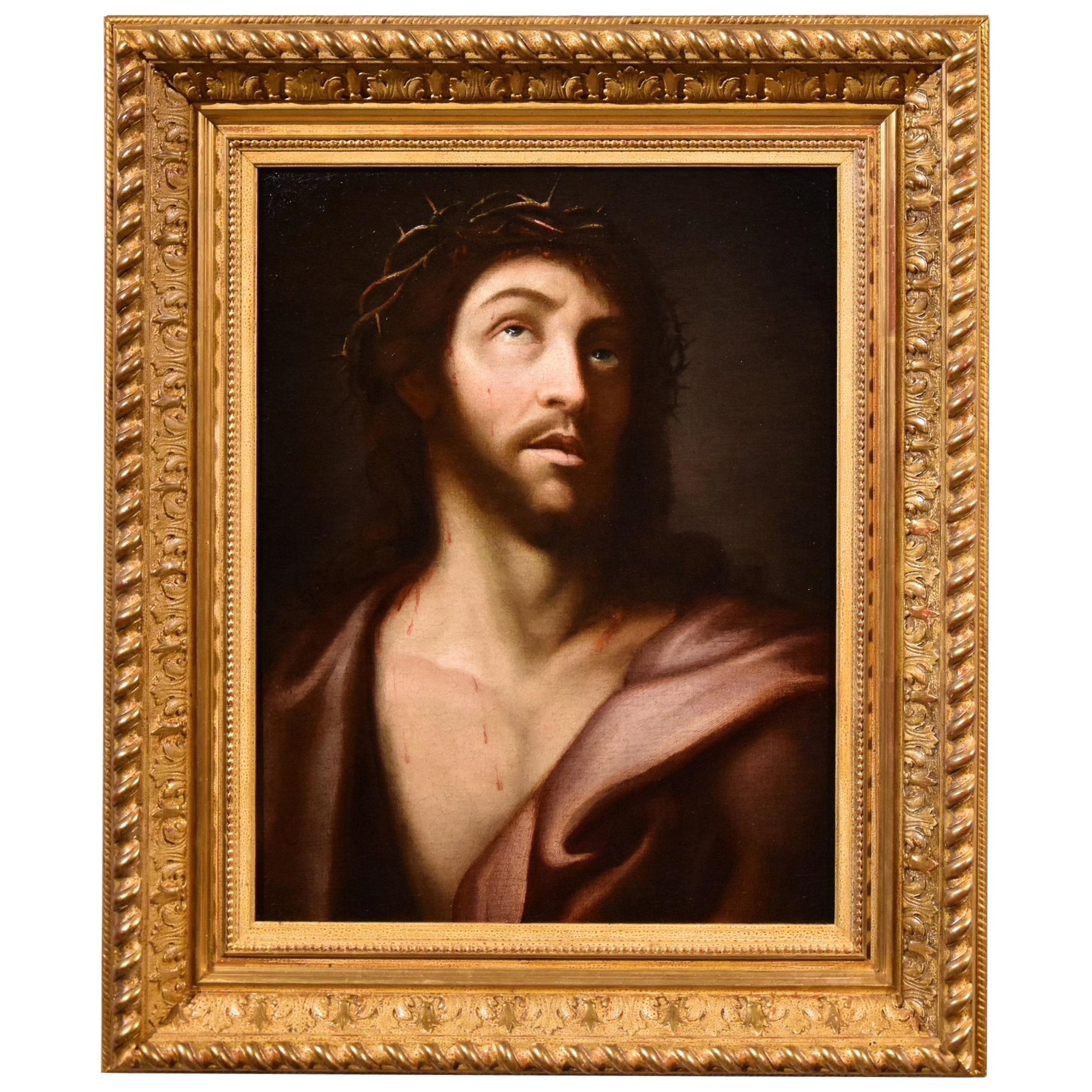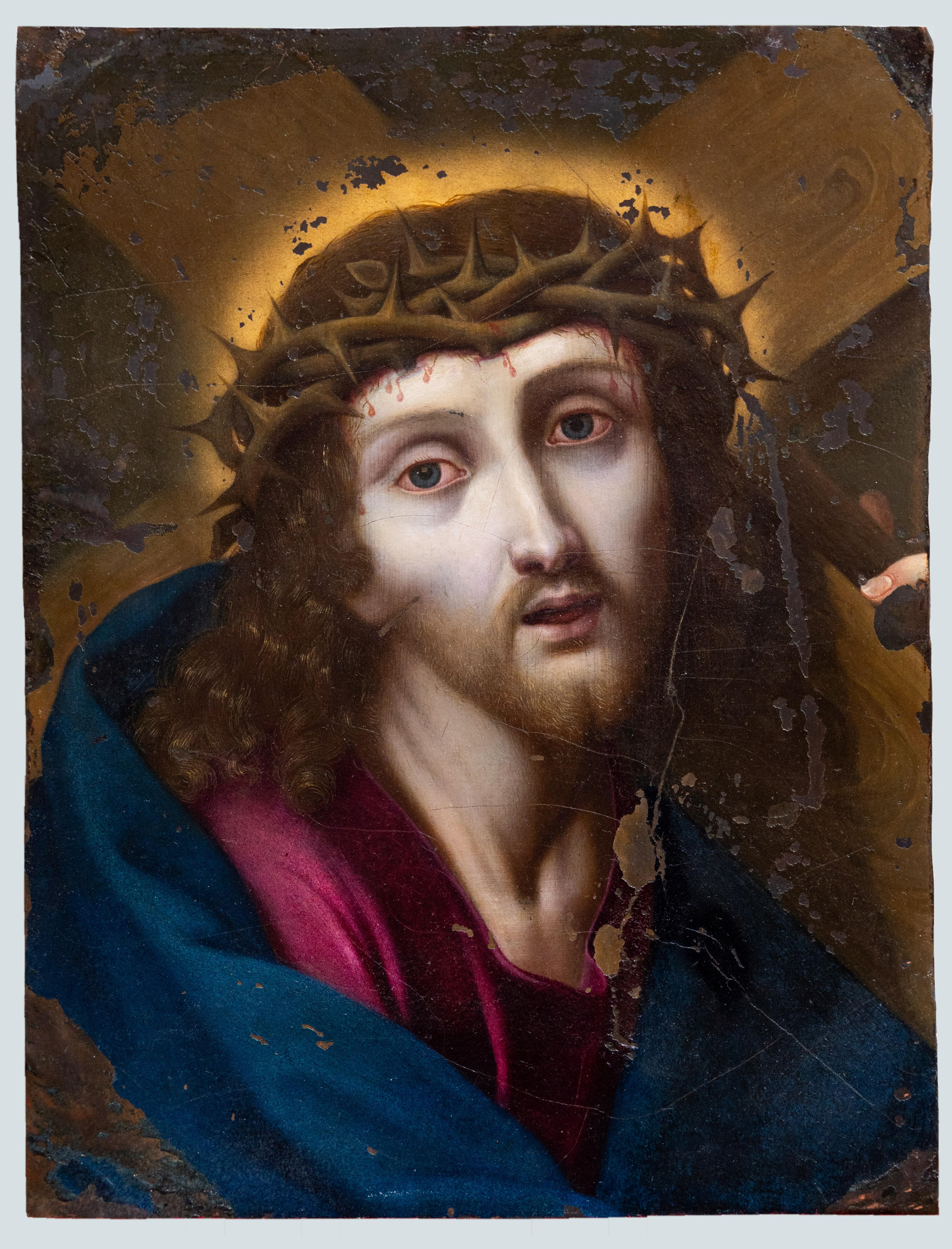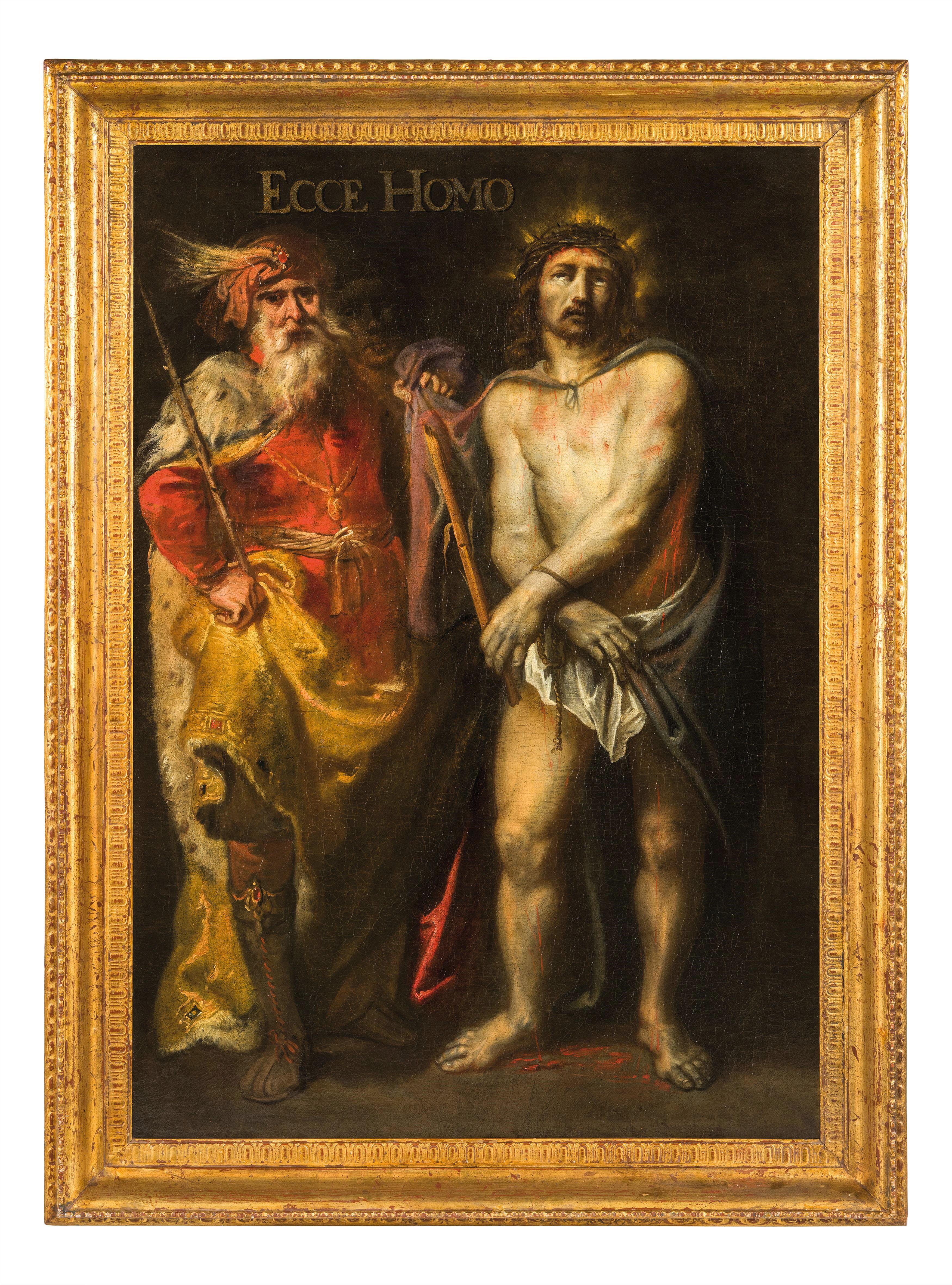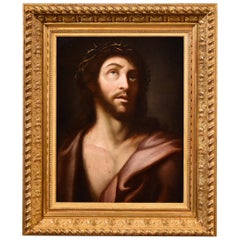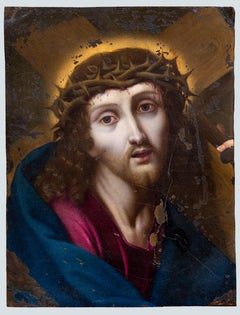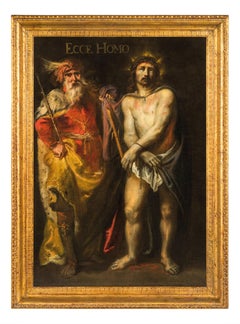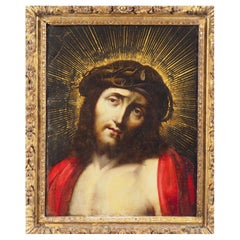Items Similar to Ecce Homo Castello 17th Century Paint Oil on canvas Old master Genoese school
Video Loading
Want more images or videos?
Request additional images or videos from the seller
1 of 20
Ecce Homo Castello 17th Century Paint Oil on canvas Old master Genoese school1650-1699
1650-1699
$14,926.95
$18,658.6920% Off
£11,102.44
£13,878.0520% Off
€12,480
€15,60020% Off
CA$20,847.38
CA$26,059.2320% Off
A$22,624.54
A$28,280.6820% Off
CHF 11,904.06
CHF 14,880.0820% Off
MX$274,888.80
MX$343,61120% Off
NOK 149,036.64
NOK 186,295.8020% Off
SEK 140,331.56
SEK 175,414.4520% Off
DKK 95,046.19
DKK 118,807.7320% Off
About the Item
17th-century Genoese School
Workshop of Valerio Castello (Genoa, 1624 - Genoa, 1659)
Ecce homo
Oil on canvas
117 x 99 cm.
In frame 138 x 118 cm.
The Ecce Homo, the subject of our intense canvas, is the Gospel episode during which Jesus, awaiting his condemnation and after his scourging, is presented to the people by Pilate, then the Roman governor of Judea, whom we see portrayed here at his side wearing a turban in the Middle Eastern style. To his right a henchman, with an amused look, holds the rope that binds Christ's hands.
The canvas immortalises the moment when the Saviour accepts his final destiny: in his face, not only humiliation but also a moment of deep introspection and emotion. He is then portrayed with a crown of thorns placed over his long hair and stripped of his clothes, his hands tied and crossed, alluding to his immediate crucifixion on Golgotha.
‘’Ecce homo‘’, which literally means ‘Here is the Man’, was the phrase uttered by Pilate himself to designate the scourged Jesus and to ingratiate himself with the crowd, aware that he had condemned an innocent man.
This type of portrayal of Christ would be very widespread in the 16th century, giving rise to particularly intense creations, capable of moving even those who do not prefer subjects with such a strong emotional impact. Whipped and mocked while awaiting his martyrdom, it is striking that his face appears sad, resigned, but not suffering, evoking the compassion he granted his executioners.
The composition, with its intense devotional character, fits easily into the mid-seventeenth-century Genoese milieu and specifically into the figurative repertoire of Valerio Castello (Genoa, 1624 - 1659); an interpreter of a new compositional conception, breaking with the Genoese pictorial tradition, through a recovery of the masters of sixteenth-century Mannerism and a careful observation of the works of the Flemish, first and foremost Rubens, and the Venetians present in abundance in Genoese collections.
Within the sphere of Genoese figurative culture, no-one like Castello was able to interpret, through the liveliness of the compositional rhythm and palette, the new feeling of an era that favoured a strong theatricality, which is well suited to the staging of our subject.
ADDITIONAL INFORMATION:
The work sold is completed by a nice antique but not coeval frame and comes with a certificate of authenticity and guarantee.
We take care of and organise the transport of the purchased works, both for Italy and abroad, through professional and insured carriers. It is also possible to see the painting in the gallery in Riva del Garda, we will be happy to welcome you to show you our collection of works.
Contact us, without obligation, for any additional information.
- Creation Year:1650-1699
- Dimensions:Height: 54.34 in (138 cm)Width: 46.46 in (118 cm)
- Medium:
- Movement & Style:
- Circle Of:Valerio Castello (Genoa, 1624 - Genoa, 1659) (1624 - 1659)
- Period:
- Condition:
- Gallery Location:Riva del Garda, IT
- Reference Number:1stDibs: LU988115714162
About the Seller
4.9
Platinum Seller
Premium sellers with a 4.7+ rating and 24-hour response times
Established in 2017
1stDibs seller since 2018
260 sales on 1stDibs
Typical response time: 4 hours
- ShippingRetrieving quote...Shipping from: Riva del Garda, Italy
- Return Policy
Authenticity Guarantee
In the unlikely event there’s an issue with an item’s authenticity, contact us within 1 year for a full refund. DetailsMoney-Back Guarantee
If your item is not as described, is damaged in transit, or does not arrive, contact us within 7 days for a full refund. Details24-Hour Cancellation
You have a 24-hour grace period in which to reconsider your purchase, with no questions asked.Vetted Professional Sellers
Our world-class sellers must adhere to strict standards for service and quality, maintaining the integrity of our listings.Price-Match Guarantee
If you find that a seller listed the same item for a lower price elsewhere, we’ll match it.Trusted Global Delivery
Our best-in-class carrier network provides specialized shipping options worldwide, including custom delivery.More From This Seller
View AllEcce Homo Christ Paint Oil on canvas 17th Century Old master Leonardo Italian
Located in Riva del Garda, IT
Lombard painter of the seventeenth century
Ecce Homo
Oil painting on canvas
56 x 43 cm. , framed 75 x 63 cm.
Provenance: Florence, Pandolfini, 5.10.2021, lot 209
The proposed canv...
Category
17th Century Old Masters Paintings
Materials
Oil
$5,979 Sale Price
20% Off
Ecce Homo Christ Metsys 16th Century Paint Oil on table Flemish Old master
Located in Riva del Garda, IT
16th-century Flemish master
Circle of Quentin Metsys (Leuven, 1466 - Antwerp, 1530)
Ecce Homo
oil on panel
cm. 34 x 23
with frame 47 x 37 (not contemporary)
An important painting...
Category
16th Century Old Masters Paintings
Materials
Oil
$7,349 Sale Price
20% Off
Ecce Homo Coxie Paint 16/17th Century Paint Oil on table Old master Flemish Art
Located in Riva del Garda, IT
Circle of Michael Coxie (Malines, 1499 - Malines, 1592)
Ecce Homo with Pontius Pilate
Oil on panel
Flemish school 16th-17th century
112 x 81 cm - framed 121 x 90 cm.
The proposed p...
Category
16th Century Old Masters Paintings
Materials
Oil
$8,470 Sale Price
20% Off
Christ Cross Religious Van Dyck 17th Century Paint Oil on canvas Old master
By Anthoon van Dyck (Antwerp 1599 - London 1641)
Located in Riva del Garda, IT
Anthoon van Dyck (Antwerp 1599 - London 1641) workshop
Christ Carrying the Cross - 17th century
Oil on canvas (120 x 94 cm - framed 140 x 112 cm).
This remarkable canvas, depic...
Category
17th Century Old Masters Paintings
Materials
Oil
$17,165 Sale Price
20% Off
Jesus Son Salvi Paint Oil on canvas Old master 17th Century Italian Religious
Located in Riva del Garda, IT
Ancient painting depicting Jesus with the Commissioner's son
(Alternative reading: St. Joseph with the Child, or the 'Paternity')
Giovan Battista Salvi known as "the Sassoferrato" (1609 - 1685) circle / follower
Oil painting on canvas
76 x 59 cm. -With frame in the shape of a small temple, not coeval 99 x 84 cm.
The interesting canvas that we are pleased to offer you recalls the iconographic model of classic paternity, which traditionally sees Saint Joseph holding the sleeping baby Jesus...
Category
17th Century Old Masters Paintings
Materials
Oil
$5,418 Sale Price
40% Off
Resurrection Christ Tiziano 16/17th Century paint Oil on canvas Old master Italy
By Tiziano Vecellio (Pieve di Cadore 1490 - Venice 1576)
Located in Riva del Garda, IT
The Resurrection of Christ
Follower of Tiziano Vecellio (Pieve di Cadore 1490 - Venice 1576)
Venetian school of the late 16th/early 17th century
Oil on canvas
108 x 78 cm. - Framed 129 x 99 cm.
This jewel of the Venetian school, a work executed between the 16th and 17th centuries by a Venetian artist, illustrates the episode of the Resurrection of Christ: as reported in the Gospel of Matthew (Matthew 28:1-7) the event is accompanied by an explosion of light and glow, with the figure of Christ rising into the sky.
Christ's face, serene and victorious, looks up towards the Light and the Infinite, in contrast to his majestic figure, here constructed with the appearance of a classical sculpture, contrasted by an intensely luminous background.
The Risen One firmly holds in His hand the banner (white with a red cross) of the Resurrection, also known as the flag of St. George, which iconographically represents His victory over death, while raising His right hand in a blessing act. With his feet he crushes a snake and a skull, a sign of Christ's triumph over sin and death.
The painting belongs to the Venetian school and presents clear reminiscences with the works of Titian Vecellio...
Category
17th Century Old Masters Paintings
Materials
Oil
$8,096 Sale Price
20% Off
You May Also Like
Ecce Homo, after Carlo Dolci (1616–1686)
Located in GB
Ecce Homo is a superb, striking and emotive Old Master in oil on copper after the renowned Italian Baroque artist Carlo Dolci. The "Ecce Homo" shows the figure of Christ before His c...
Category
17th Century Baroque Figurative Paintings
Materials
Copper
Old Master Flemish Oil on Canvas Baroque Painting Jesus Christ Ecce Homo 1630
Located in Portland, OR
An important Old Master oil on canvas painting by the Flemish artist, Jan Cossiers, a follower of the style of Caravaggio (1600-1671).
Born in Antwerp in 1600, Jan Cossiers was a pupil of his father, the painter Antoon Cossiers (died 1646/1647), and also studied under Cornelis de Vos...
Category
17th Century Baroque Figurative Paintings
Materials
Canvas, Oil
Escuela española (XVIII) - Ecce Homo - Óleo sobre tabla
Located in Sant Celoni, ES
La obra no va firmada
Se presenta enmarcada con un marco de principios del siglo xx en madera tallada
El estado de la obra se puede ver, presenta craquelaciones y faltas de pintura...
Category
Mid-18th Century Old Masters Figurative Paintings
Materials
Oil
17th Century Flemish School after Le Correge, "Ecce Homo"
Located in Madrid, ES
17th-century Flemish School, after Le Correge, "Ecce Homo,"
oil on copper in a Louis XVI frame
51 x 41 cm
(small parts missing),
with collector's inscriptions on the back
good condit...
Category
Antique 17th Century Dutch Baroque Paintings
Materials
Paint
15th Century By Maestro della Pala Sforzesca Ecce Homo Tempera on Panel
Located in Milano, Lombardia
15th Century Maestro della Pala Sforzesca
Title: Ecce Homo
Medium: Tempera on Panel
Dimensions: without frame 64.9 x 53.2 – with frame 82 x 70 x 5 cm
Beautiful "cassetta" frame in e...
Category
15th Century and Earlier Old Masters Figurative Paintings
Materials
Panel, Tempera
Amazing Tiziano Vecellio's Circle of the 17th century "Ecce Homo"
Located in Madrid, ES
Amazing Tiziano Vecellio's Circle of the 17th century "Ecce Homo"
Oil on canvas, 17th century,
based on the original housed in the Kunsthistorisches Museum, Vienna.
Dimensions: 1...
Category
Antique 17th Century Italian Baroque Paintings
Materials
Paint
More Ways To Browse
Antique Governor
Italian Oil Painting Old Man
16th Century Old Master Painting
17th Century Painting Of Christ
Antique Whip
Crown Of Thorns
Turban Style
Contemporary Korean Art
Winter Scene
Female Artist Mid Century Modern
Paintings Of Rivers
Impressionist Garden
The Used Drafting
Yellow Portrait
Palma Mallorca
19th Century British School Landscapes
Mid Century Pastel Art
Landscape Painting Water
